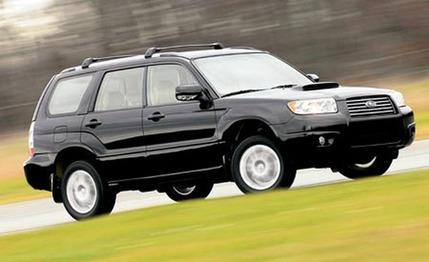 Specialty File
Specialty File
There are a number of cars that we drive, get out of, and think: "This would be really great, if only we could give it more power, or tweak the suspension, or…" So now we've put our money where our collective mouth is-the goal was to keep each modification under $1000-and we'll demonstrate how simple and fairly inexpensive performance modifications can benefit certain vehicles. We'll call this occasional series Demon Tweaks.
Our debut guinea pig is a 2006 Subaru Forester 2.5XT Limited, a vehicle we've admired for its roomy interior and punchy, 224-hp turbocharged engine. Although that engine is the same one found in the barn-burning WRX, the Forester XT has a suspension that's too soft for our tastes. The mission, therefore, was to sharpen the handling with different tires and a retuning of the suspension. More power is never a bad thing, so we also cranked up the engine by increasing the turbo boost via a reprogrammed engine computer.
Our three-stage sharpening of the Forester cost us $1745, which is only six percent of the XT's $29,850 as-tested price.
STAGE 1: High-performance tires
Cost: $600
Okay, we know what you're thinking: Anyone knows performance tires will improve a car's handling. But changing tires isn't always a panacea for handling ills.
In the Forester XT's case, the stock Yokohama Geolander G900 all-season tires (P215/60R-16s) weren't designed to carve up corners. They have tall, squishy sidewalls and pulled only 0.74 g on the skidpad. We replaced them with a $600 set of Toyo Proxes T1Rs, a high-performance street tire, in the widest size (225/55ZR-16) that would fit on the stock seven-inch-wide rims. The Toyos are smaller in diameter (25.6 inches versus 26.2), so this change gave us a slight speedometer error (at 70 mph, the speedometer reads 73 with the Toyos). However, the payoffs are increased grip of 0.81 g, a marked improvement in steering response, and a useful reduction in stopping distance. Replacing all-season tires with hi-po rubber is an easy performance-enhancing swap on any car, but remember that stickier rubber will likely be borderline dangerous on snow.
STAGE 2: Stiffer anti-roll bars
Cost: $450
Although the Toyos gave us more grip, the front end of the Forester still tended to slide (understeer) when we turned aggressively into corners. The additional grip also increased the Forester's substantial body roll: Understeer, like our XT's, can sometimes be alleviated by adjusting the tire pressures, but this didn't stop the front-end plowing. Next we tried disconnecting the stock front anti-roll bar, which makes the front-to-rear roll-stiffness ratio slightly more rear-biased and should cause the rear end to slide, getting rid of the push. But it didn't.
So we installed a $450 set of anti-roll bars from Cobb Tuning. These bars are about twice as stiff as the stock ones, and the rear is adjustable. The installation took about two hours, and we were off to the skidpad, where we found that by putting the rear bar at its stiffest setting, we achieved neutral handling balance. The XT could now be pitched into a corner at any attitude or drifted as desired. In the bargain, we got a tick more grip on the skidpad (0.82 g) and a reduction in body roll.
The Forester's handling still isn't as crisp as an STI's, but it's damn close. More to the point, we didn't ruin the XT's ride in our quest for neutral handling—it's slightly stiffer, but not at all offensive.
STAGE 3: Computer reflash
COST: $695
The 2.5XT's engine computer controls how much boost the turbo delivers, so increasing the engine's power output is a simple matter of reprogramming to provide more boost. That's why turbocharged engines are far more responsive to electronic tuning than naturally aspirated ones.
Again, we went to Cobb Tuning, this time for its $695 Stage 1 AccessPort, a cell-phone-sized unit that plugs into the car's OBD II port. In about 10 minutes, AccessPort uploads a new program that increases the maximum boost from 11.6 psi to 13.5 and adjusts the air-to-fuel ratio and spark timing. The result, says Cobb, is an additional 26 horsepower.
To illustrate the difference, it's best to look at our three rolling-start acceleration tests, as these avoid the variability of standing-start launches. These tests were from 5 to 60 mph, where at 5 mph in first gear we floor the accelerator and shift through the gears until we clear 60 mph; the 30-to-50-mph and 50-to-70 tests are conducted in top (fifth) gear.
Generally, performance improved. The stock XT ran 5 to 60 in 7.4 seconds; with the new software, that time dropped to 7.1. For 50-to-70, the time fell from the stock car's 7.7 seconds to 6.3. In the 30-to-50 test, where the engine isn't making much boost in top gear, we saw no improvement. And we found only a 0.2-second improvement in the quarter-mile time (14.5 seconds versus 14.3).
Even so, we could feel the extra juice, which isn't always the case with a $695 power upgrade.
In the end we had turned our XT into the wagon we had wanted Subaru to build in the first place. It's quicker and far more fun to toss through the twisties, yet it rides reasonably well—an impressive result for less than two grand.